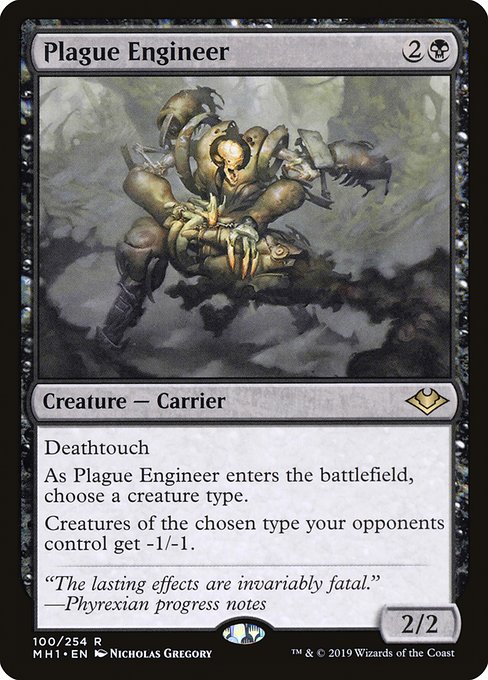
Image courtesy of Scryfall.com
Shaping the Meta: Plague Engineer as a Benchmark for Meta-Aware Card Design
In the ever-accelerating tempo of Magic: The Gathering, set designers and players alike crave cards that don’t just sit on a stack but actively whisper about the future of the game. Plague Engineer, a rare from Modern Horizons, offers a compact glimpse into meta-aware design—where a card’s power, identity, and flavor are tuned to influence how opponents build and play around it. At three mana, black-aligned, and armed with deathtouch, it arrives with a bold promise: name a creature type, and the creatures of that type your opponents control shrink by 1 power and 1 toughness. The moment it ETBs, your opponents weigh a new dynamic in their lineups: “Which type will they name? And how do we adapt to avoid the tax?” 🧙♂️🔥
Designers have long experimented with “tribal” mechanics and the social contract of commander and modern formats. Plague Engineer pushes meta-awareness in two intertwined directions. First, its enter-the-battlefield timing creates a strategic moment. Second, the once-flexible concept of “creature types” becomes a shared surface for counterplay and deck-building sacrifices. The ability forces opponents to anticipate you may target a tribe they’re leaning on, effectively turning a single card into a meta-signal. In practice, you can leverage the naming choice to punish overrepresented tribes in a given metagame or to set up favorable trades with agile blockers and deathtouch edge. It’s a small card with a loud whisper: “Your plan exists inside a framework where your opponent’s choices matter just as much as your own.” ⚔️
The card’s flavor text—“The lasting effects are invariably fatal.”—reads like a grim joke from Phyrexian progress notes, and it underscores a larger theme in future design: meta-aware cards that not only affect the board but also nudge players toward deeper strategic thinking about identity, synergy, and timing. Plague Engineer is black through and through: deathtouch embodies the ruthless efficiency of a necrotic march toward inevitability, while the creature-type naming mechanic makes for clever mind games. The card’s rarity and set—Modern Horizons (mh1), a drafting-innovation set that looks both forward and backward in time—signal that Wizards is comfortable exploring retrofitted tribal complexity in contemporary spaces. 🧙♂️💎
“The lasting effects are invariably fatal.”
From a gameplay perspective, Plague Engineer shines in decks that pivot around specific tribes, like zombies, vampires, or bounded Phyrexian swarms. In tribal-rich formats, you’ll find that choosing a type your opponent already exploits can simultaneously curb their offense and sharpen your own board state. The -1/-1 impact may seem minor at a glance, but in persistent board states, it compounds quickly—especially when you combine deathtouch with high-value blockers or evasive threats. Meta-aware design like this invites a broader conversation about how the next wave of cards can anticipate meta shifts: what if future designers embed “adaptive” costs or effects that respond to the most-played tribes in a given season? The dream is to foster decks that feel both personal and globally resonant, a balance that Plague Engineer achieves with its crisp, efficient frame. 🧲
In terms of color and mechanic identity, Plague Engineer embodies black’s strength in resource disruption, creature interaction, and strategic complexity. The card scales well in formats where creature density is high and removal is a scarce, valuable resource. It also opens a door to interesting Commander dynamics: naming a creature type can shape not just the board but opponents’ draw decisions, potentially steering the whole game toward colorless or off-tribe subgames where your deck’s own synergy can shine more brightly. That’s the essence of meta-aware design—cards that compel playstyle evolution without sacrificing clarity or fairness. The balance between Deathtouch, a low-cost body, and a global -1/-1 tax is a deliberate choice that rewards careful timing and thoughtful sequencing. ⚖️
Beyond the table, Plague Engineer also speaks to a broader cultural moment in MTG—where players celebrate not only bomb spells but the quiet ingenuity of how a card’s text can shape the strategy landscape. It’s a nod to creative problem-solving, a wink to long-running tribal narratives, and a reminder that the best cards sometimes appear modest yet carry the weight of future possibilities. In the spirit of Modern Horizons’ design philosophy, it’s easy to imagine a future lineup where meta-aware interactions become standard play patterns, giving players more tools to express their decks’ personalities and more chances to outthink their opponents with elegance and a touch of darkest humor. 🧙♂️🎨
For collectors and theoreticians alike, Plague Engineer also nudges the conversation toward how we value and track cards that age into “meta fixtures.” Its rarity, foil options, and price points tell a story about demand, playability, and the evolving vocabulary of tribal disruption. Even as a single creature, it invites a broader narrative about how future sets could embed more robust meta-signals—perhaps through more nuanced naming mechanics, or by coupling a tribe-targeting effect with synergy across adjacent tribes. The potential is vast, and the design space is ripe for exploration as players push to craft meta-aware engines that feel both novel and inevitable. 🧲💎
To add a little practical flavor for readers who like to translate theory into play, consider using Plague Engineer as a testing ground in casual or kitchen-table metas. Try naming a tribe you anticipate opponents will commit to in the next few turns—watch how it reshapes their lineups, from tempo plays to resource allocation. If you’re brewing for Commander, you can pair this with boards that leverage deathtouch bodies and value from incremental advantage, turning a single ETB line into a long, quiet game of chess where every creature type name becomes an incantation of strategic intent. The future of design is not merely in the big spells; it’s in the clever, meta-aware architecture that makes players think twice before committing to a given path. 🧙♂️🔥
custom-gaming-mouse-pad-9x7-neoprene-high-res-color
More from our network
- https://blog.digital-vault.xyz/blog/post/how-visual-texture-boosts-viewer-retention-in-ads/
- https://blog.rusty-articles.xyz/blog/post/spidops-through-the-ages-early-sets-to-modern-scarlet-violet/
- https://crypto-acolytes.xyz/blog/post/verifiable-credentials-in-web3-building-a-trustworthy-web/
- https://transparent-paper.shop/blog/post/behavioral-targeting-explained-how-it-works-and-why-it-matters/
- https://blog.zero-static.xyz/blog/post/how-myr-propagator-transforms-late-game-commander-decks/